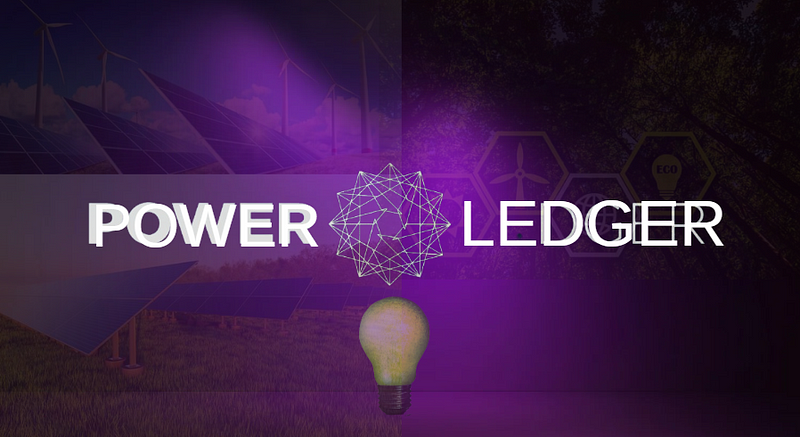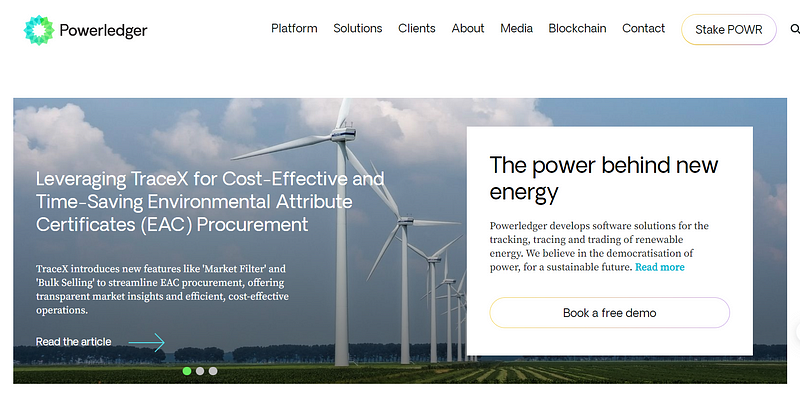
CRYPTO PROJECT RESEARCH
POWER LEDGER (POWR): A Blockchain Solution for the Future of Energy
Revolutionising Energy Markets with Blockchain Technology
The energy sector is undergoing a major transformation, as the world shifts towards renewable sources and decentralized systems. However, there are still many challenges and inefficiencies in the current energy markets, such as lack of transparency, high costs, and grid instability.
How can blockchain technology help to solve these problems and create a more sustainable and democratic energy system?
What’s Power Ledger?
Power Ledger is a technology company that develops software solutions for the tracking, tracing and trading of renewable energy and environmental commodities. It aims to provide a platform for a fully modernized, market-driven grid that offers consumers a choice in their energy while driving the democratization of power.

Power Ledger operates on two blockchain layers and uses two tokens, the Power Ledger (POWR) and Sparkz tokens. The platform itself uses the public Ethereum blockchain and a private consortium blockchain known as EcoChain™.
The POWR token is an ERC-20 token that acts as a licence required for businesses such as; utilities, renewable energy operators, microgrids, companies committed to 100% renewable energy and property developers to access Power Ledger’s platform.
POWR is traded through the Ethereum Smart Bond exchange. Sparkz are stable tokens that represent units of energy and are used for transactions within the platform. Sparkz are pegged to the local currency of each market and are issued and redeemed by Power Ledger.
How Does Power Ledger Work?
Power Ledger offers a range of products and services that enable different actors in the energy ecosystem to track, trace and trade energy, flexibility services and environmental commodities. Some of the key products are:
- uGrid: A peer-to-peer (P2P) energy trading platform that allows consumers and producers to trade excess solar energy within a building or a microgrid. uGrid also enables grid operators to manage demand and supply more efficiently and reduce network costs.
- xGrid: A P2P energy trading platform that allows consumers and producers to trade excess solar energy across the distribution network. xGrid also enables grid operators to incentivize distributed energy resources (DERs) to provide grid services and enhance grid reliability.
- TraceX: A platform that allows the creation and trading of environmental attribute certificates (EACs), such as renewable energy certificates (RECs), carbon credits, and green gas certificates. TraceX introduces new features like ‘Market Filter’ and ‘Bulk Selling’ to streamline EAC procurement, offering transparent market insights and efficient, cost-effective operations.
- Vision: A platform that allows consumers to monitor and verify their energy consumption and production data in real time, using blockchain and smart meter technology. Vision also allows consumers to participate in demand response programs and access dynamic pricing schemes.
- Power Purchase Agreements (PPA) Vision: A platform that allows renewable energy developers and buyers to create and manage PPAs using smart contracts. PPA Vision simplifies the PPA process, reduces transaction costs, and increases trust and transparency between parties.
- Mode Flex: A platform that allows electric vehicle (EV) owners and operators to optimize their charging and discharging behavior, using blockchain and smart charging technology. Mode Flex also allows EV owners and operators to participate in energy and flexibility markets and provide grid services.
- Local Energy Market (LEM): A platform that allows the creation and operation of local energy markets (LEMs), where consumers and producers can trade energy and flexibility services using blockchain and smart grid technology. LEMs enable the integration of DERs, increase grid resilience, and empower local communities.
Founder and Team
Power Ledger was co-founded by Dr. Jemma Green and John Bulich in 2016. Dr Jemma Green is the executive chairman of Power Ledger. After a decade in corporate finance in the UK, Dr Green returned home to Perth to pursue a doctorate at Curtin University in electricity market disruption, which she completed in 2017.

This work turned out to be the perfect segue to founding Power Ledger. John Bulich is the technical director at Power Ledger. Before co-founding Power Ledger, he was a co-founder and director of Ledger Assets and a director at WA Property Investments.
The Power Ledger team consists of over 40 members, with expertise in blockchain, energy, software, business, and marketing. Some of the key members are:
- Dave Martin: Co-founder and managing director. Dave has over 20 years of experience in the electricity industry and is a leading advocate for the decentralization of power.
- Dr Gov van Ek: Co-founder and director. Gov is a serial entrepreneur and investor, with a background in corporate finance, venture capital, and blockchain.
- Bill Tai: Board advisor and ambassador. Bill is a venture capitalist and a pioneer in the blockchain space. He is also the co-creator of the Extreme Tech Challenge (XTC), which Power Ledger won in 2018.
- Vinod Tiwari: Head of business development and sales. Vinod is responsible for driving the global expansion and adoption of Power Ledger’s products and services.
- Anya Nova: Crypto economist and head of business development. Anya is an expert in token economics and blockchain governance, and leads the research and development of Power Ledger’s token models.
Updates in 2023
Power Ledger has been busy in 2023, with several updates and achievements in its product development, partnerships, and recognition. Some of the highlights are:

In January, Power Ledger announced the launch of its first project in the Middle East, in partnership with EDF, the world’s largest electricity company. The project will enable P2P energy trading within a new residential development in Dubai, using Power Ledger’s uGrid platform
In February, Power Ledger released a new version of its TraceX platform, with enhanced features and functionalities. The new version introduces a ‘Market Filter’ feature, which allows buyers to filter EACs by various criteria, such as location, technology, vintage, and price. It also enables ‘Bulk Selling’ of EACs, which allows sellers to offer multiple EACs in one transaction, reducing transaction costs and increasing liquidity.
In March, Power Ledger won the prestigious Global Smart Energy Elites Award, in the category of ‘Digitalisation Project of the Year’. The award recognizes Power Ledger’s project with Tata Power-DDL, India’s leading power distribution company, which facilitates P2P energy trading from over 2MW of solar PV systems between 150 meters in North Delhi.

In April, Power Ledger expanded its partnership with Thai energy group TDED, to develop a blockchain-based digital energy business. The partnership will leverage Power Ledger’s xGrid, TraceX, and Vision platforms, to enable P2P energy trading, EAC trading, and energy data management across Thailand.
In May, Power Ledger published a new report, titled ‘Blockchain in Energy: A Key Catalyst for Shaping the Future Grid’. The report explores the use of blockchain for transparency and envisions a future grid where consumers play a pivotal role in balancing markets and fostering innovation in energy.
Partnerships in 2023
Power Ledger has established partnerships with various players in the energy sector, ranging from utilities, retailers, developers, regulators, and communities. Some of the notable partnerships in 2023 are:
- EDF: Power Ledger partnered with EDF, the world’s largest electricity company, to enable P2P energy trading within a new residential development in Dubai, using Power Ledger’s uGrid platform. The project is the first of its kind in the Middle East and aims to demonstrate the benefits of blockchain for energy efficiency, carbon reduction, and customer empowerment.
- Tata Power-DDL: Power Ledger partnered with Tata Power-DDL, India’s leading power distribution company, to facilitate P2P energy trading from over 2MW of solar PV systems between 150 meters in North Delhi. The project is the first live P2P energy trading project in India and showcases the potential of blockchain for grid modernization, renewable integration, and consumer choice.
- TDED: Power Ledger expanded its partnership with Thai energy group TDED, to develop a blockchain-based digital energy business. The partnership will leverage Power Ledger’s xGrid, TraceX, and Vision platforms, to enable P2P energy trading, EAC trading, and energy data management across Thailand. The partnership also aims to support Thailand’s goal of achieving 30% renewable energy by 2037.
- ekWateur: Power Ledger partnered with ekWateur, France’s leading green energy retailer, to bring P2P energy trading to hundreds of thousands of French customers. The partnership will use Power Ledger’s xGrid platform, to allow customers to choose their energy mix and source their electricity from local renewable generators.
- RENergy: Power Ledger partnered with RENergy, a renewable energy company in South Africa, to create a digital record of the generation and consumption of clean energy in low-income communities. The partnership will use Power Ledger’s TraceX platform, to issue and trade EACs from solar microgrids, and Power Ledger’s Vision platform, to monitor and verify the energy data.
Tokenomics of POWR Coin
The POWR coin is the native token of the Power Ledger platform, and serves as a licence and a governance token.

The POWR coin has a fixed supply of 1 billion tokens, of which 600 million are in circulation and 400 million are reserved for the Power Ledger team, escrow, and rewards pool.
The POWR coin is traded on various exchanges, such as Binance, Huobi, and Uniswap, and has a market capitalization of about $130 million as of December 2023. The POWR coin has two main functions:
Licence: The POWR coin is required for businesses such as; utilities, renewable energy operators, microgrids, companies committed to 100% renewable energy and property developers to access Power Ledger’s platform. POWR is traded through the Ethereum Smart Bond exchange.
Governance: The POWR coin holders can participate in the governance of the Power Ledger platform, by voting on proposals and upgrades, and staking their tokens to earn rewards.
Roadmap in Q4/2023 & 2024
Power Ledger has not published an official roadmap for Q4/2023 and 2024, but based on its previous updates and announcements, some of the possible goals and milestones are:
Q4/2023:
- Power Ledger plans to launch its Mode Flex platform, which allows electric vehicle (EV) owners and operators to optimize their charging and discharging behavior, using blockchain and smart charging technology. Mode Flex also allows EV owners and operators to participate in energy and flexibility markets and provide grid services. Power Ledger also aims to expand its presence in Europe, by partnering with more green energy retailers and local energy communities.
2024:
- Power Ledger intends to scale up its existing projects and partnerships, and explore new opportunities and markets for its products and services. Power Ledger also expects to launch its Local Energy Market (LEM) platform, which allows the creation and operation of local energy markets (LEMs), where consumers and producers can trade energy and flexibility services using blockchain and smart grid technology.
- LEMs enable the integration of distributed energy resources (DERs), increase grid resilience, and empower local communities.
